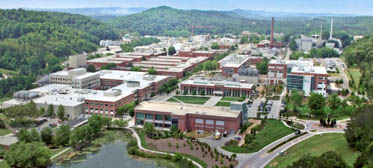Oak Ridge National Lab (ORNL) – in Oak Ridge Tennessee, USA. The Historic lab was founded to support the Manhattan project and went on to pioneer nuclear power.
Molten salt reactors (MSRs) represent a class of reactors that use liquid salt, usually fluoride- or chloride-based, as either a coolant with a solid fuel (such as fluoride salt-cooled high temperature reactors) or as a combined coolant and fuel with fuel dissolved in a carrier salt. For liquid-fuelled MSRs, the salt is sometimes also processed online or in a batch mode to allow for removal of fission products as well as introduction of fissile fuel and fertile materials during reactor operation. The MSR is most commonly associated with the U-233/Thorium fuel cycle, as the nuclear properties of U-233 combined with the online removal of parasitic absorbers allow for the ability to design a thermal-spectrum breeder reactor; however, MSR concepts have been developed using all neutron energy spectra (thermal, intermediate, fast, and mixed-spectrum zoned concepts) and with a variety of fuels including uranium, thorium, plutonium, and minor actinides.
Early MSR work was supported by a significant research and development (R&D) program that resulted in two experimental systems operating at ORNL in the 1960s, the Aircraft Reactor Experiment and the Molten Salt Reactor Experiment. Subsequent design studies in the 1970s focusing on thermal-spectrum thorium-fueled systems established reference concepts for two major design variants: (1) a molten salt breeder reactor (MSBR), with multiple configurations that could breed additional fissile material or maintain self-sustaining operation; and (2) a denatured molten salt reactor (DMSR) with enhanced proliferation-resistance. T MSRs has been selected as one of six most promising Generation IV systems and development activities have been seen in fast-spectrum MSRs, waste-burning MSRs, MSRs fueled with low-enriched uranium (LEU), as well as more traditional thorium fuel cycle-based MSRs. Work on MSR projects such as motors, pumps, fluidic diodes, valves and fittings as well as super alloys continues to this day at the Oak Ridge National Lab (Gehin, J., Powers, J. 2016)



